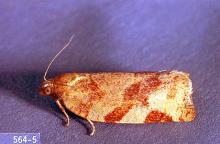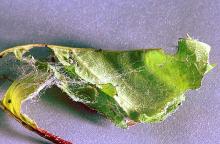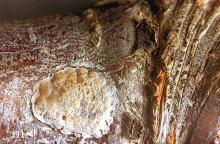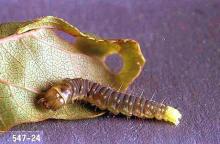Archips argyrospila
Pest description and crop damage Mature larvae are 0.75 inch in length and greenish with a black head. Overwintering eggs start hatching about the time trees begin to bloom. Newly hatched larvae may work into blossoms and damage developing cherries. Larvae damage buds and developing fruit and roll leaves.
Biology and life history The single-generation leafrollers overwinter as egg masses on twigs and branches. Eggs hatch in spring as buds are opening until petal fall. The larvae feed for 4 to 6 weeks, then pupate in the rolled leaves, and emerge as moths in early summer. The overwintering eggs are laid in July.
Management-biological control
Spiders and parasitic wasps, as well as predators like the brown lacewing, greatly reduce leafroller populations throughout the year.
Management-cultural control
Hand-pick rolled leaves containing larvae or pupae. Removal of overwintering sites, such as rolled leaves on the ground can reduce next year's population.
Management-chemical control: HOME USE
Dormant-season spray
Apply sprays using enough water to cover the entire tree thoroughly including small limbs. Apply only during dormant or delayed-dormant period.
- horticultural mineral oil-Some formulations OMRI-listed for organic use.
Growing-season spray
Warning: Many pesticides are hazardous to bees. Look for bee precautionary statements on product labels and do not use these products during bloom or if bees are foraging in the orchard.
- azadirachtin (neem oil)-Some formulations are OMRI-listed for organic use.
- Bacillus thuringiensis var. kurstaki-Some formulations are OMRI-listed for organic use.
- carbaryl-Highly toxic to bees.
- malathion-Highly toxic to bees.
- pyrethrins-Some formulations are OMRI-listed for organic use. Highly toxic to bees.
- zeta-cypermethrin-Highly toxic to bees.
Management-chemical control: COMMERCIAL USE
Dormant-season spray
- diazinon (Diazinon AG500) at 4 pints/A + horticultural mineral oil (rates vary; see product label). REI 4 days. Do not exceed one dormant application of diazinon per season.
- horticultural mineral oil-Rates vary; check product label. REI varies; check product label. Some formulations are OMRI-listed for organic use.
- pyriproxyfen (Esteem 35WP) at 4 to 5 oz/A + horticultural mineral oil (rates vary; see product label). REI 12 hr. Pyriproxyfen is a growth regulator with activity toward egg and immature stages only. Under heavy scale pressure, use the higher rate.
Growing-season sprays
Warning: These materials are hazardous to bees. Do not use during bloom or if bees are foraging in the orchard.
- carbaryl (Carbaryl 4L) at 1 to 2 lb ai/A (2 to 3 quarts/A). REI 12 hr. PHI 3 days. Extremely toxic to aquatic invertebrates; avoid spray drift and runoff to surface waters.
- chlorantraniliprole (Altacor 35WDG) at 3 to 4.5 oz/A. REI 4 hr. PHI 10 days. Do not apply more than 9 oz/A per season.
- diazinon (Diazinon 50W) at 1 lb/100 gal water. Do not exceed 4 lb/A per year (2 lb ai/A per year). Do not exceed one foliar application per season. REI 4 days. PHI 21 days. Do not apply within 300 ft of aquatic habitat.
- lambda-cyhalothrin (Warrior II) 1.28 to 2.56 fl oz/A. REI 24 hr. PHI 14 days. May disrupt beneficial mite populations. Extremely toxic to fish; avoid spray drift and surface runoff.
- malathion (Malathion 57E) at 1.5 pints/A. REI 12 hr. PHI 3 days.
- methoxyfenozide (Intrepid 2F) at at 0.12 to 0.25 lb ai/A (8 to 16 fl oz/A). REI 4 hr. PHI 7 days. Additional applications at 10- to 18-day intervals at maximum rates may be required for heavy infestations, sustained moth flight, situations in which it is difficult to achieve thorough coverage, and for quicker knockdown of larvae. Do not apply more than 58 fl oz /A per season. See label for biofix information. Do not apply within 25 ft of an aquatic habitat, 150 ft if applied by air.
- spinetoram (Delegate WG) at 4.5 to 7 oz/A. REI 4 hr. PHI 7 days. Do not apply more than a total of 28 oz of Delegate WG (0.438 lb ai spinetoram) per acre per year.
- spinosad (Entrust SC) at 0.06 to 0.12 lb ai/A (4 to 8 fl oz/A). REI 4 hr. PHI 7 days. Results are best when applied at petal fall. OMRI-listed for organic use. May act slowly. Do not exceed 0.45 lb ai/A spinosad (29 fl oz/A) per year.
Resistance management Fruit tree leafrollers can develop resistance rapidly to chemical controls. Resistance management techniques include using sampling and pest action thresholds to make spray decisions, using higher thresholds on young, non-bearing trees, and rotating pesticides with different modes of action. Spinetoram and spinosad are in the same insecticide class and same mode of action.





